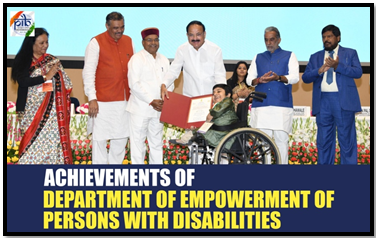PICTURED WITH DIGNITY: SUPREME COURT’S FRAMEWORK FOR SENSITIVE PORTRAYAL OF PERSONS WITH DISABILITIES
Syllabus:
- GS-2- Vulnerable sections in India , their issues and remedies , Judicial activism in the related field
Focus :
- The article focuses on the Supreme Court’s recent ruling which laid down a framework for the sensitive portrayal of Persons with Disabilities (PwDs) in visual media. It emphasizes the importance of avoiding stereotypes, ensuring dignity, and promoting a human rights-based model of disability in films and other visual content.
Source - TH
Introduction
- On July 8, the Supreme Court of India delivered a landmark judgment outlining a framework for the representation of Persons with Disabilities (PwDs) in visual media.
- This ruling was in response to an appeal against the Delhi High Court’s verdict concerning the movie Aankh Micholi, which featured characters with various disabilities.
- Disability activists and scholars had criticized the film’s trailer for perpetuating stereotypes and prejudices against PwDs.
- While the Supreme Court did not pass any adverse order against Sony Pictures under the Rights of Persons with Disabilities Act, 2016 (RPWD Act) or the Cinematograph Act, 1952, it elaborated on several fundamental principles regarding disability rights.
| Major Schemes of the Government of India for the Welfare of Differently Abled People
1. Accessible India Campaign (Sugamya Bharat Abhiyan) o Launched in 2015, this campaign aims to make public spaces, transportation systems, and information technology accessible to persons with disabilities (PwDs). o The campaign focuses on three verticals: built environment, transportation, and information & communication technology. o Conducting accessibility audits of at least 50% of all government buildings in state capitals and making them fully accessible. o Making 25% of public transport vehicles fully accessible. o Ensuring accessibility of 50% of railway stations and airports. 2. Deendayal Disabled Rehabilitation Scheme (DDRS) o This scheme supports NGOs working for the welfare of PwDs. o It provides financial assistance to organizations to develop comprehensive services and facilities. o Support for rehabilitation centers, including those providing physiotherapy, speech therapy, and occupational therapy. 3. National Fellowship for Persons with Disabilities (RGMF) o Named after Rajiv Gandhi, this fellowship scheme supports students with disabilities for higher education such as MPhil/PhD in Indian universities. o Fellowship is provided to students with disabilities to pursue higher education. 4. Assistance to Disabled Persons for Purchase/Fitting of Aids and Appliances (ADIP Scheme) o Launched in 1981, the ADIP Scheme aims to assist PwDs in procuring modern, standard aids, and appliances that can promote their physical, social, and psychological rehabilitation. o Provides grants-in-aid to NGOs, institutes, and organizations for purchasing aids and appliances for PwDs. |
Human Rights Model of Disability
Human Rights Model:
- The Supreme Court emphasized the human rights model of disability, which goes beyond the traditional social and medical models.
- The medical model views disability as a medical condition within an individual, while the social model identifies disability in societal attitudes and structures.
- The human rights model, embedded in international human rights law, views disability as a natural part of human diversity and recognizes PwDs as rights holders whose inclusion in society must be ensured.
Positive Obligation:
- The human rights model places a positive obligation on governments and private entities to facilitate the effective participation of PwDs.
- The extent of private bodies’ obligations under the RPWD Act has been debated. In Vikash Kumar vs UPSC, the Supreme Court acknowledged these obligations but also recognized their limitations in the current case.
Creative Freedom vs. Stereotyping
Creative Freedom:
- The Supreme Court stated that creative freedom does not include the freedom to lampoon, stereotype, misrepresent, or disparage marginalized groups.
- The ‘intention’ and ‘overall message’ of a film are crucial in determining whether it perpetuates stereotypes.
Stereotypes and Attitudinal Barriers:
- Stereotypes play a significant role in perpetuating attitudinal barriers against PwDs.
- The Court emphasized that stereotypes operationalize discrimination and undermine the dignity of individuals, protected under Article 21.
Cinematic Speech, Hate Speech, and Group Defamation
Differentiating Speech Types:
- The Supreme Court distinguished between cinematic speech, hate speech, and group defamation laws.
- Hate speech marginalizes individuals based on group membership, often leading to hatred or violence.
- Group defamation, akin to individual defamation, targets a specific group, perpetuating stereotypes and discrimination.
Context of Speech Analysis:
- The Court employed a ‘context of speech’ analysis, focusing on the impact on human dignity, the identity of the speaker and target, and the linguistic connotation.
- Expressions targeting marginalized communities and reinforcing prejudices are not protected under Article 19(1)(a).
Guidelines for Representation of PwDs
Nine-Point Guidelines:
- The Supreme Court issued nine guidelines to ensure sensitive portrayal of PwDs in visual media.
- These guidelines cover language usage, consultation with disability advocacy groups, and ensuring dignity in representation.
Nuanced Portrayal:
- The Court called for a more nuanced portrayal of disability and PwDs in mainstream films.
- Examples like the film Srikanth demonstrate how media can sensitively depict PwDs, promoting inclusivity and dignity.
Conclusion
- The Supreme Court’s ruling is a timely intervention that underscores the need for a more sensitive understanding of disability in visual media.
- By emphasizing the human rights model and providing clear guidelines, the Court aims to balance creative freedom with the necessity to avoid stereotypes and discrimination.
- This framework is expected to pave the way for more respectful and accurate representations of PwDs in the media, contributing to their inclusion and participation in society.
Source:The Hindu
Associated article
https://universalinstitutions.com/reaching-out-to-include/
Mains Practice Question :
GS-2
- “Discuss the Supreme Court’s recent ruling on the portrayal of Persons with Disabilities (PwDs) in visual media. How does the ruling aim to balance creative freedom and the need to avoid stereotypes and discrimination?”(250 Words)




